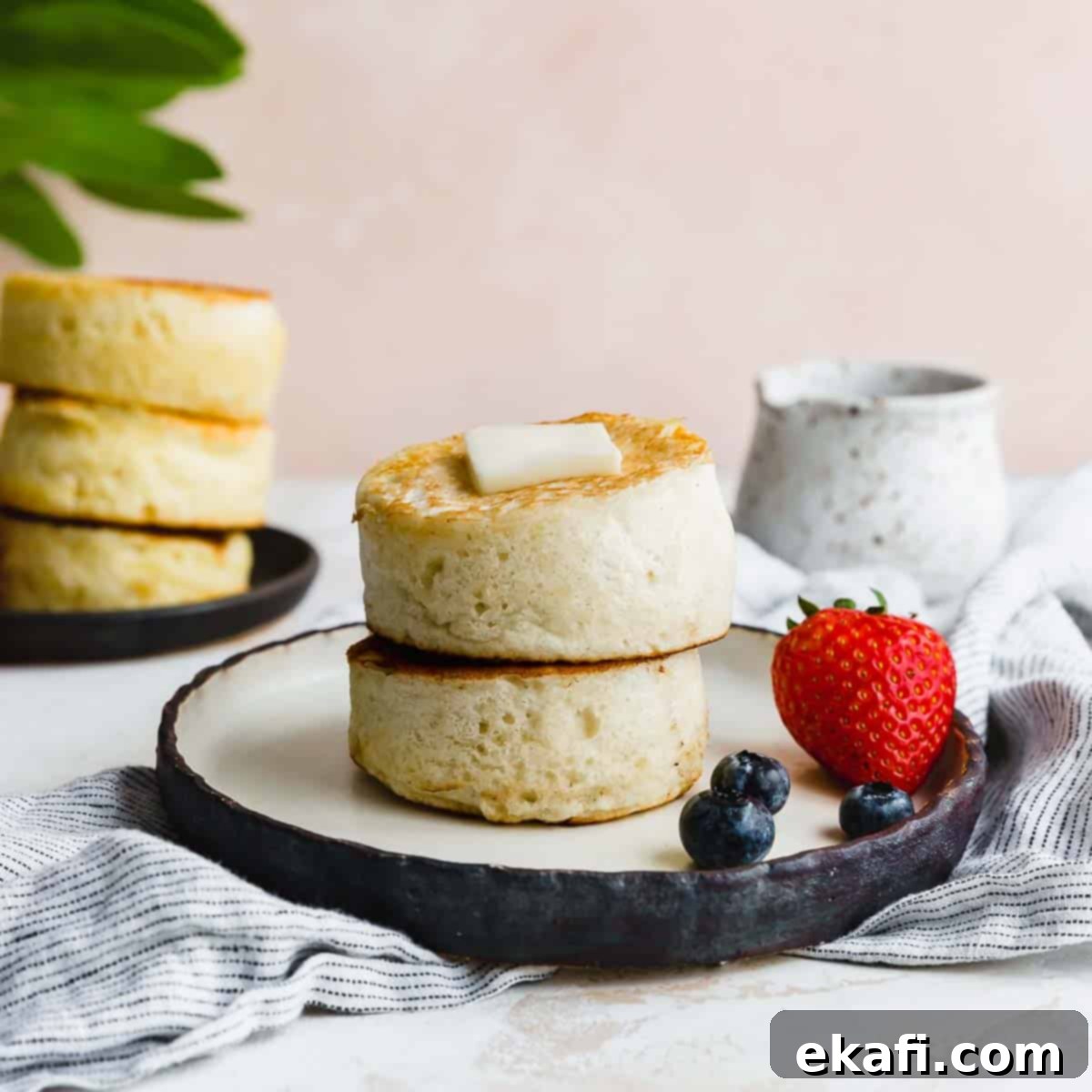The Ultimate Guide to Incredibly Fluffy Japanese Soufflé Pancakes: A Detailed Recipe for Perfect Results
Prepare to elevate your breakfast game with these truly phenomenal Japanese Fluffy Pancakes, often known as soufflé pancakes. These aren’t just any pancakes; they are a culinary experience. Imagine biting into a cloud: thick, wonderfully soft, and delightfully billowy. With their delicate, airy texture on the inside, encased in a beautifully golden-brown exterior, they promise a pancake breakfast that is both visually stunning and incredibly delicious.
While these magnificent pancakes hail from Japan, their versatility means you can enjoy them just like you would traditional pancakes. Don’t hesitate to pile on your favorite toppings! Whether it’s a cascade of fresh berries, a generous drizzle of warm maple syrup, a dollop of homemade whipped cream, a dusting of powdered sugar, or a scattering of chocolate chips, these soufflé pancakes provide the perfect canvas for your sweet cravings. For an extra special treat, serve them with a side of crisp bacon or a fresh fruit salad to balance the sweetness.
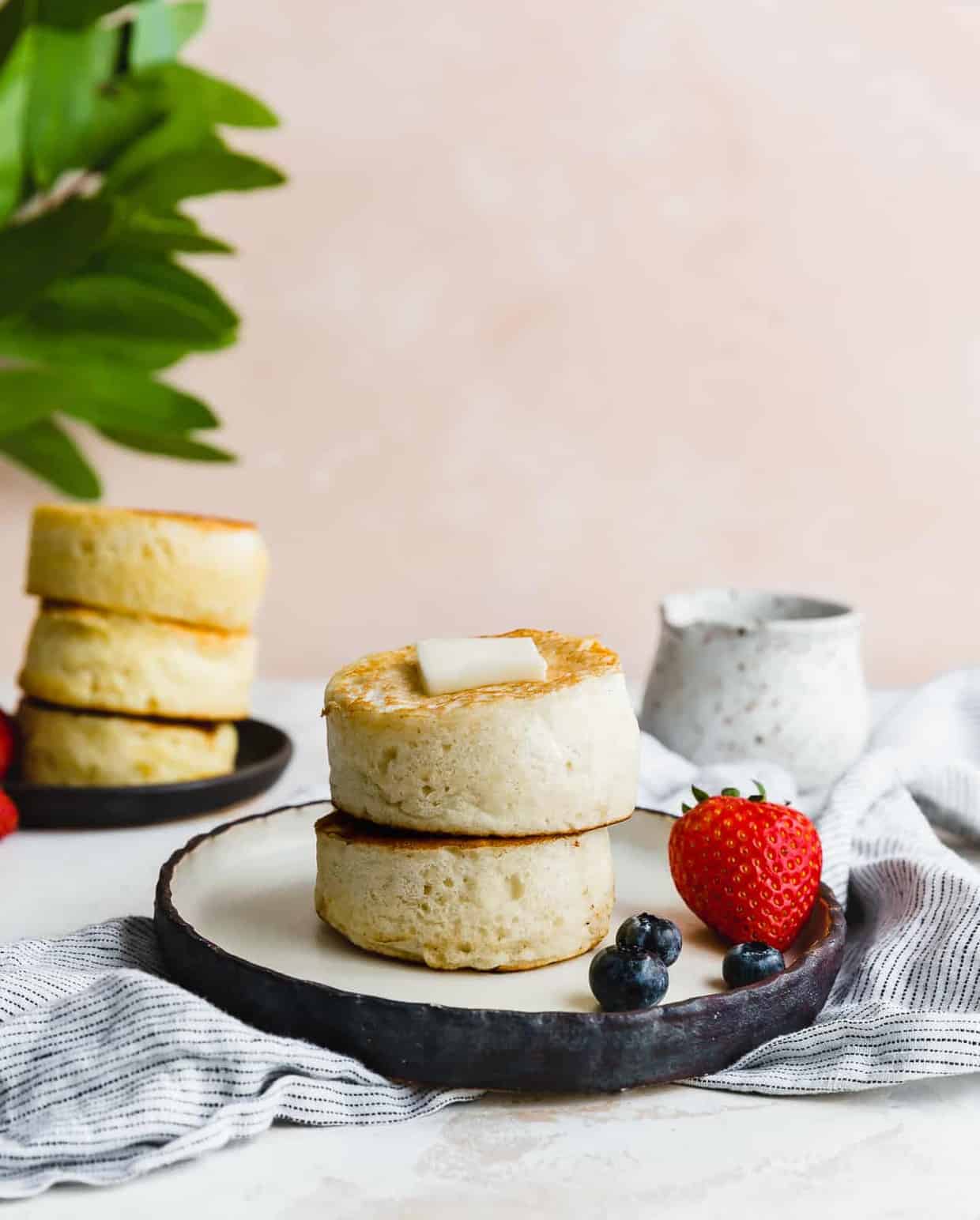
Why This Japanese Pancake Recipe Works So Well
Crafting perfect Japanese soufflé pancakes can seem daunting, but this recipe is meticulously designed to guide you through every step, ensuring success even for novice bakers. Here’s why this particular recipe stands out:
- Achieving Ultimate Fluffiness: The secret to truly “fluffy” Japanese pancakes lies in mastering the egg whites. Many recipes fall short, but ours emphasizes the precise technique for beating egg whites into perfectly stiff peaks. This creates a stable meringue that incorporates maximum air into the batter, leading to those signature sky-high, melt-in-your-mouth soufflé pancakes you crave. We leave no room for guesswork, ensuring your pancakes rise beautifully every time.
- Detailed, Foolproof Instructions: We understand that making soufflé pancakes (or スフレパンケーキ, as they’re known in Japanese!) can be a bit intimidating. That’s why this recipe provides incredibly detailed, step-by-step instructions with invaluable tips and troubleshooting advice built right in. No matter your prior kitchen experience, you’ll feel confident tackling this delicious challenge. We believe that no incredible food should ever feel out of reach, and our comprehensive guide makes these Japanese fluffy pancakes accessible to everyone.
- Perfect Balance of Flavor and Texture: Beyond just the incredible fluffiness, this recipe also delivers on taste. The carefully selected ingredients and proportions ensure a delicate sweetness and rich, buttery flavor that complements the airy texture. Each bite is a harmonious blend of light, moist interior and slightly crisp, flavorful exterior.
- Expert Tips for Common Pitfalls: We’ve anticipated common issues like deflating pancakes or uneven cooking. Throughout the recipe, you’ll find specialized tips on everything from prepping your pan to mixing your batter and knowing exactly when to flip. These insights are designed to arm you with the knowledge to avoid common mistakes and achieve consistent, perfect results.
Key Ingredients for Fluffy Japanese Pancakes
While the technique is crucial, the quality and preparation of your ingredients are equally important for achieving the best Japanese fluffy pancakes. Here’s a closer look at what you’ll need and why each component matters:
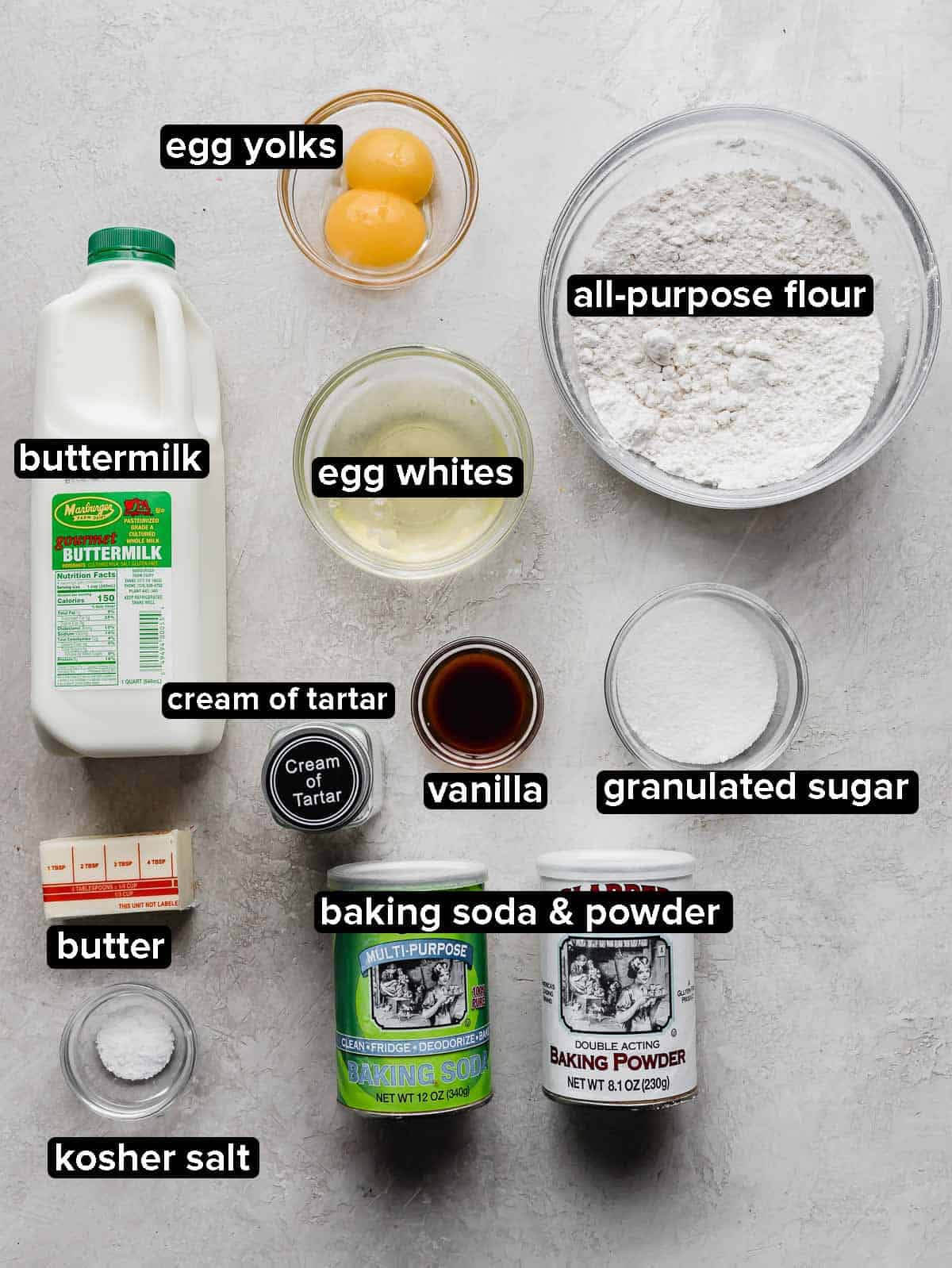
- All-Purpose Flour: This forms the base structure of your soufflé pancakes. Using regular all-purpose flour provides enough gluten for stability without making the pancakes too dense. The key is to mix it minimally to keep the texture light.
- Granulated Sugar: We use just enough sugar to sweeten these fluffy Japanese soufflé pancakes without overwhelming their delicate flavor. It also aids in browning and helps stabilize the egg whites.
- Baking Powder and Baking Soda: These chemical leavening agents work in tandem with the stiff egg whites to give the pancakes their impressive rise and airy lift. Baking soda requires an acid (like buttermilk) to activate, while baking powder has its own acid.
- Kosher Salt: Salt is essential for balancing and enhancing all the other flavors. Kosher salt has a coarser texture and less concentrated saltiness than table salt. If substituting with table salt, use about ¼ teaspoon less per teaspoon of kosher salt to avoid over-salting.
- Buttermilk: Room temperature buttermilk is crucial for the best results. Its acidity reacts with the baking soda, contributing to the pancakes’ rise and tender crumb. Beyond leavening, buttermilk also imparts a subtle tangy flavor that is a key characteristic of these delicious pancakes.
- Eggs (Separated): This is perhaps the most critical component. The egg yolks are mixed with the other wet ingredients, adding richness and a lovely yellow hue. The egg whites, however, are beaten separately into stiff peaks, creating a light, airy meringue that provides the bulk of the pancakes’ incredible fluffiness and height.
- Cream of Tartar: A small but mighty ingredient, cream of tartar is added to the egg whites during whipping. This acidic stabilizer helps to strengthen the protein structure in the egg whites, allowing them to hold more air and preventing the foam from collapsing. The result is a more stable, smoother, and long-lasting meringue.
- 3-inch x 2.5-inch Ring Molds: These metal molds are essential for achieving the signature tall, perfectly round shape of Japanese soufflé pancakes. Don’t worry if you don’t have them; check our FAQs for an easy workaround!
Step-by-Step Guide to Making Fluffy Japanese Pancakes
Follow these detailed steps carefully to achieve perfectly tall and wobbly Japanese soufflé pancakes. Precision in each stage is key to success!
- Prepare Dry Ingredients: In a large mixing bowl, thoroughly whisk together 1 ½ cups of all-purpose flour, 3 tablespoons of granulated sugar, 2 teaspoons of baking powder, ¼ teaspoon of baking soda, and ¾ teaspoon of kosher salt. Whisk well to ensure all leavening agents and salt are evenly distributed. Set this bowl aside.
- Combine Wet Ingredients: In a separate medium bowl, whisk 1 ¼ cups of room temperature buttermilk, 4 tablespoons of melted butter, 1 teaspoon of vanilla extract, and 2 egg yolks. Continue whisking until all ingredients are fully combined and the mixture is smooth. Set this aside as well.
- Whip Egg Whites to Stiff Peaks: This is arguably the most crucial step for achieving fluffy pancakes. In a clean, separate medium bowl (preferably metal or glass, as plastic can retain grease), add the 4 egg whites and ¼ teaspoon of cream of tartar. Using a hand mixer (or stand mixer with a whisk attachment), beat the egg whites on medium-high speed. Continue beating until stiff, glossy peaks form. When you lift the beaters, the egg whites should stand straight up with a slight curl at the very tip. (Refer to the “Recipe Tips” section for more details on perfect meringue.)
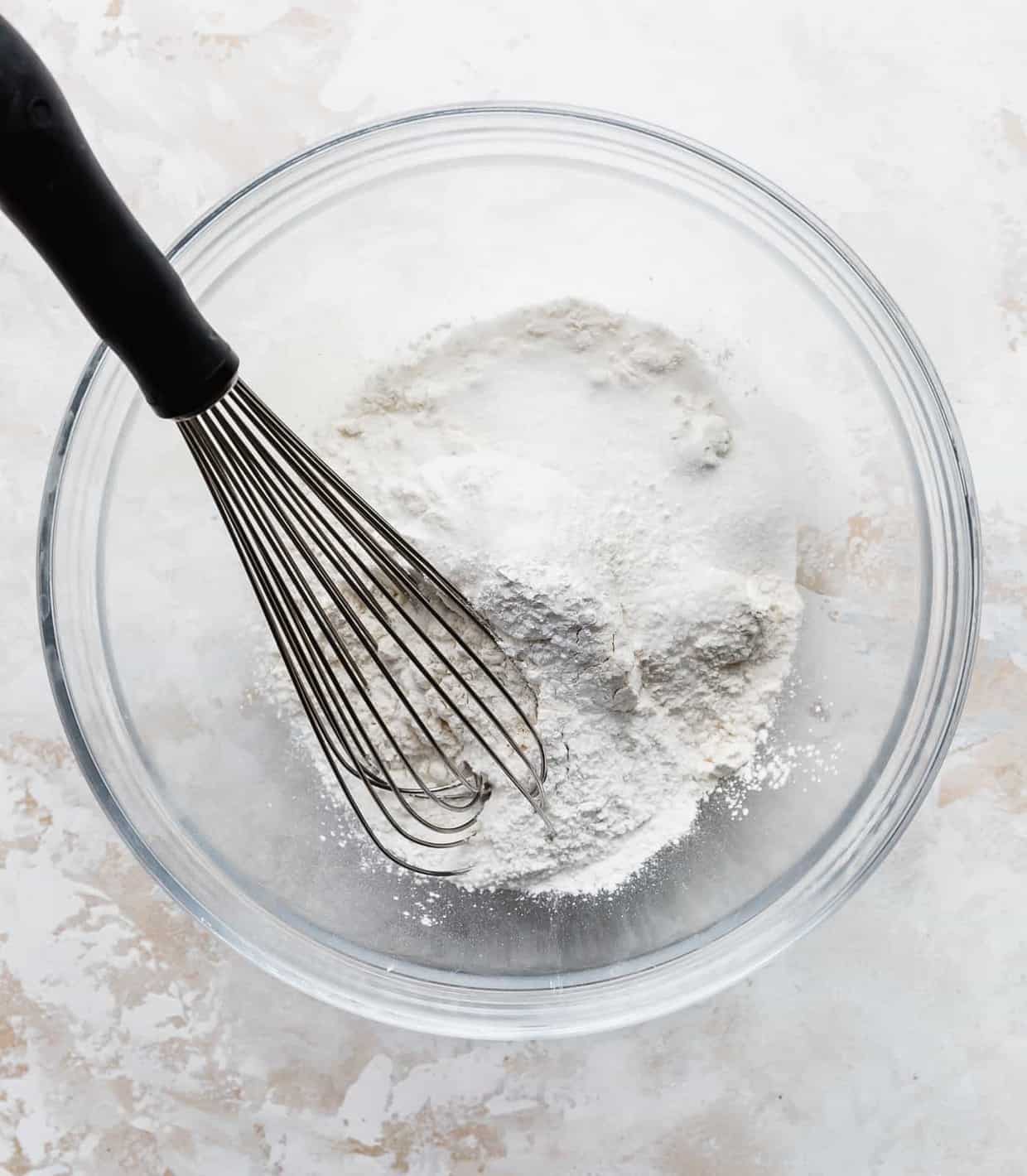
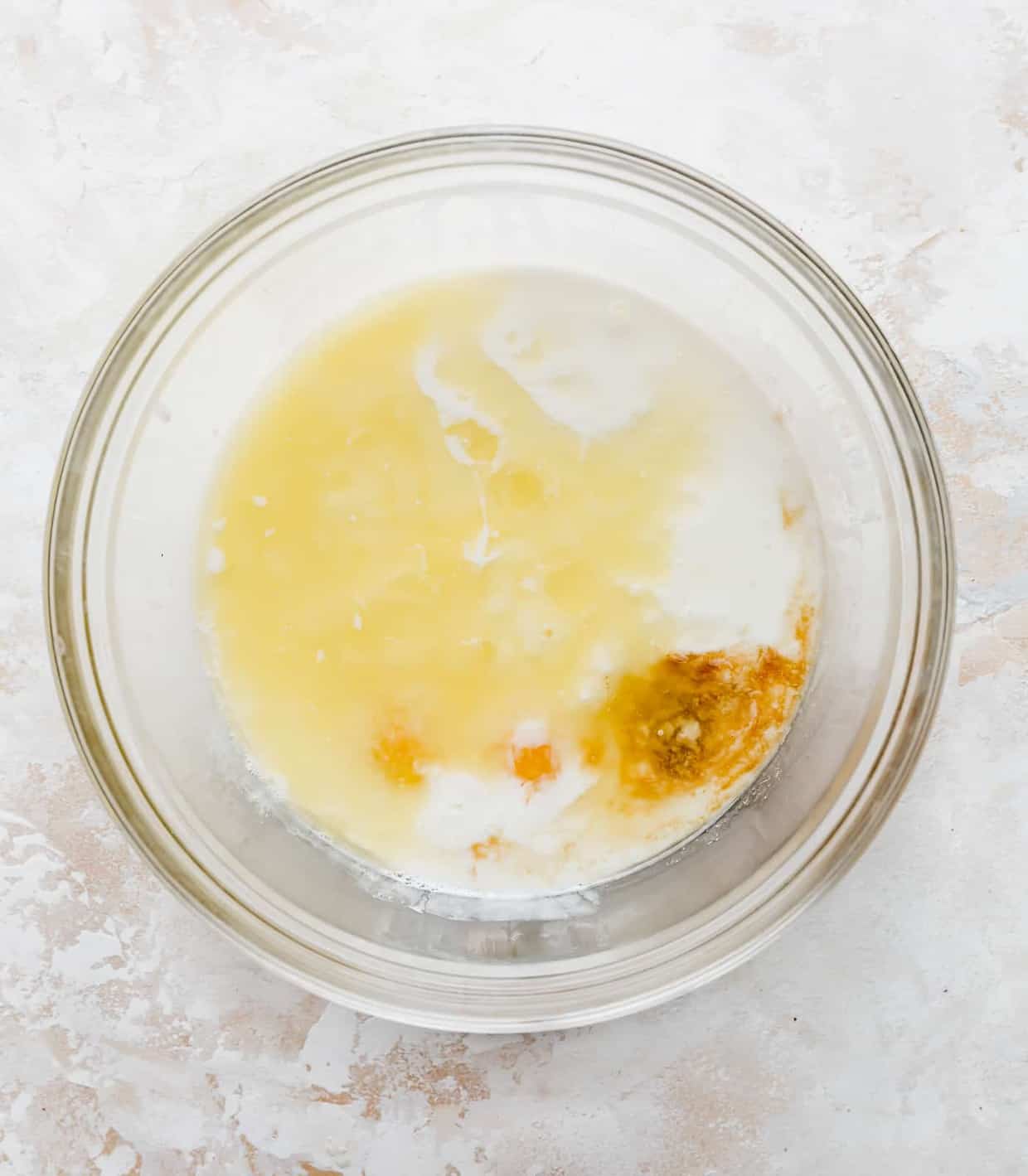
- Gently Combine Wet and Dry Ingredients: Pour the whisked buttermilk mixture into the bowl of dry ingredients. Using a rubber spatula, stir gently until the ingredients are just moistened and partially combined. Be careful not to overmix at this stage, as overworking the batter can develop gluten and lead to tough pancakes, counteracting all our efforts for fluffiness.
- Fold in the Stiff Egg Whites: Now, carefully add the whipped egg whites to the pancake batter. Gently fold them in using your rubber spatula until they are just combined. The goal is to incorporate the egg whites without deflating them, preserving all the air you worked so hard to whip in. A few small streaks of white are perfectly fine.
- Prepare Molds and Fill: Heat a large nonstick skillet or electric griddle over medium-low heat. It’s crucial to maintain a low, consistent temperature. Spray the cooking surface generously with nonstick spray. Next, spray the inside of your 3-inch by 2.5-inch ring molds thoroughly with nonstick cooking spray to prevent sticking. Place the prepared ring molds onto the warm skillet. Carefully spoon-fill each mold with a scant ½ cup of the pancake batter. Remember, DO NOT OVERFILL. The batter should only fill the mold about halfway up. This allows room for the impressive vertical rise.
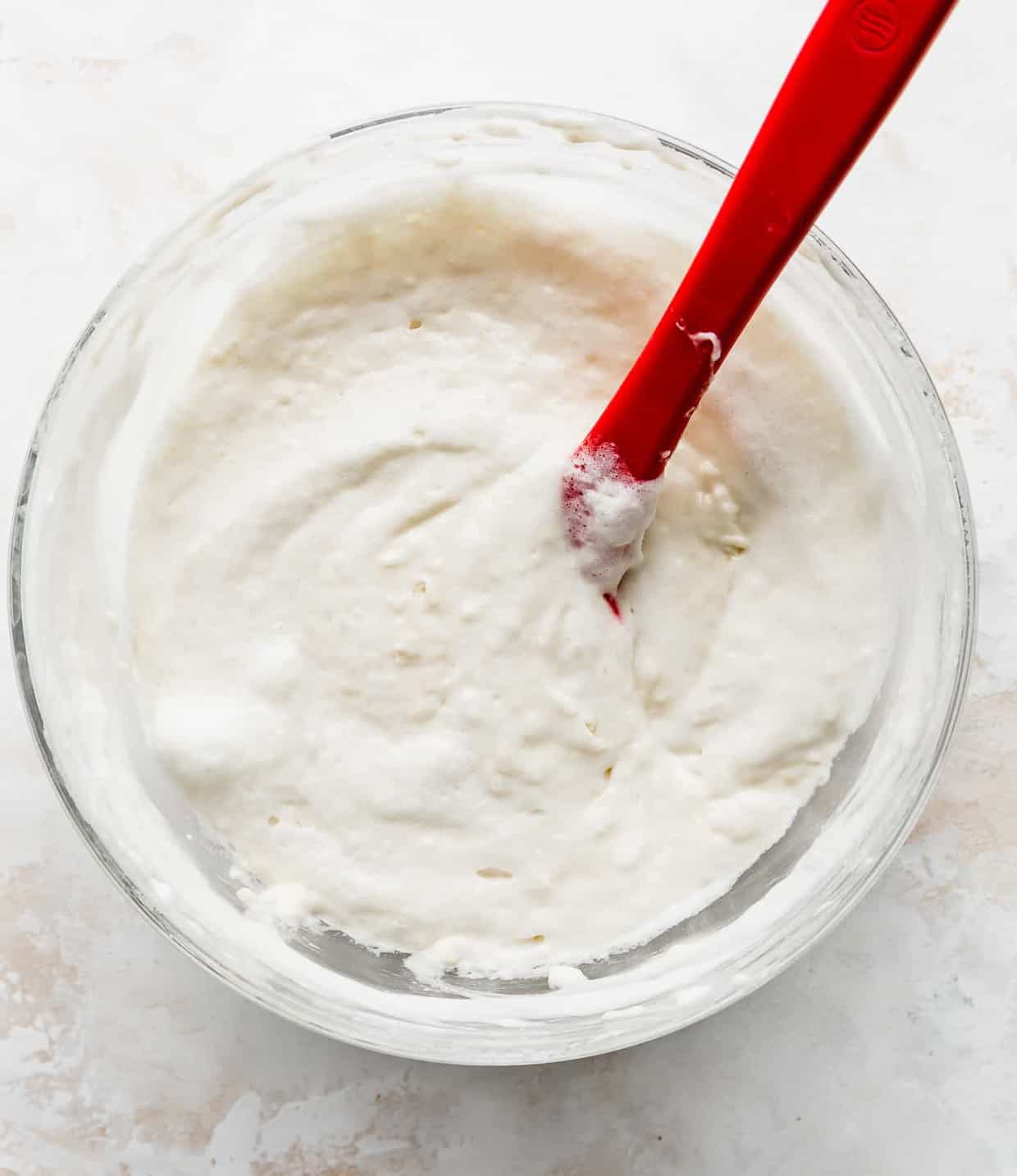
- Cook the First Side: Cover the skillet with a lid (if available) to trap steam, which helps cook the pancakes evenly and encourages a beautiful rise. Cook on medium-low heat until the batter has risen significantly, reaching the top of the mold, and the bottom of the pancake is a lovely golden brown. This usually takes about 5-8 minutes. At this point, you should see bubbles forming on the top surface of each pancake, and the center will have a slight, barely perceptible jiggle when gently nudged. Do not be tempted to flip too soon, or the uncooked batter will ooze out and compromise the shape.
- Flip the Pancakes: This step requires a gentle touch. Carefully release the bottom of each pancake from the pan by sliding a thin spatula underneath it. Using kitchen tongs, gently grasp the sides of the ring molds and carefully flip the pancakes. (If cooking one at a time, a clever trick is to rest the pancake on the spatula and bring the skillet up to meet the pancake, then turn the pancake onto the skillet. We have a short video demonstrating this technique for optimal results.) Once flipped, cover the skillet again and cook the second side for another 3-5 minutes, or until golden brown and cooked through.
- Release and Repeat: Once cooked, transfer the pancakes to a plate. To remove the mold without damaging your perfect soufflé pancakes, run a butter knife gently around the inside edge of each mold, then carefully lift and remove the mold. Before cooking the next batch, wipe down each mold and re-spray it with cooking spray to ensure a non-stick surface. Repeat the entire process with the remaining batter.
- Serve Immediately: These Japanese fluffy pancakes are best enjoyed fresh and warm. Serve them immediately with a light dusting of powdered sugar and fresh fruit, or indulge with a generous pat of butter and a drizzle of rich maple syrup. Remember, soufflé pancakes can naturally deflate over time, so aim to eat them within 30 minutes of cooking for the ultimate fluffy experience. Enjoy every single cloud-like bite!
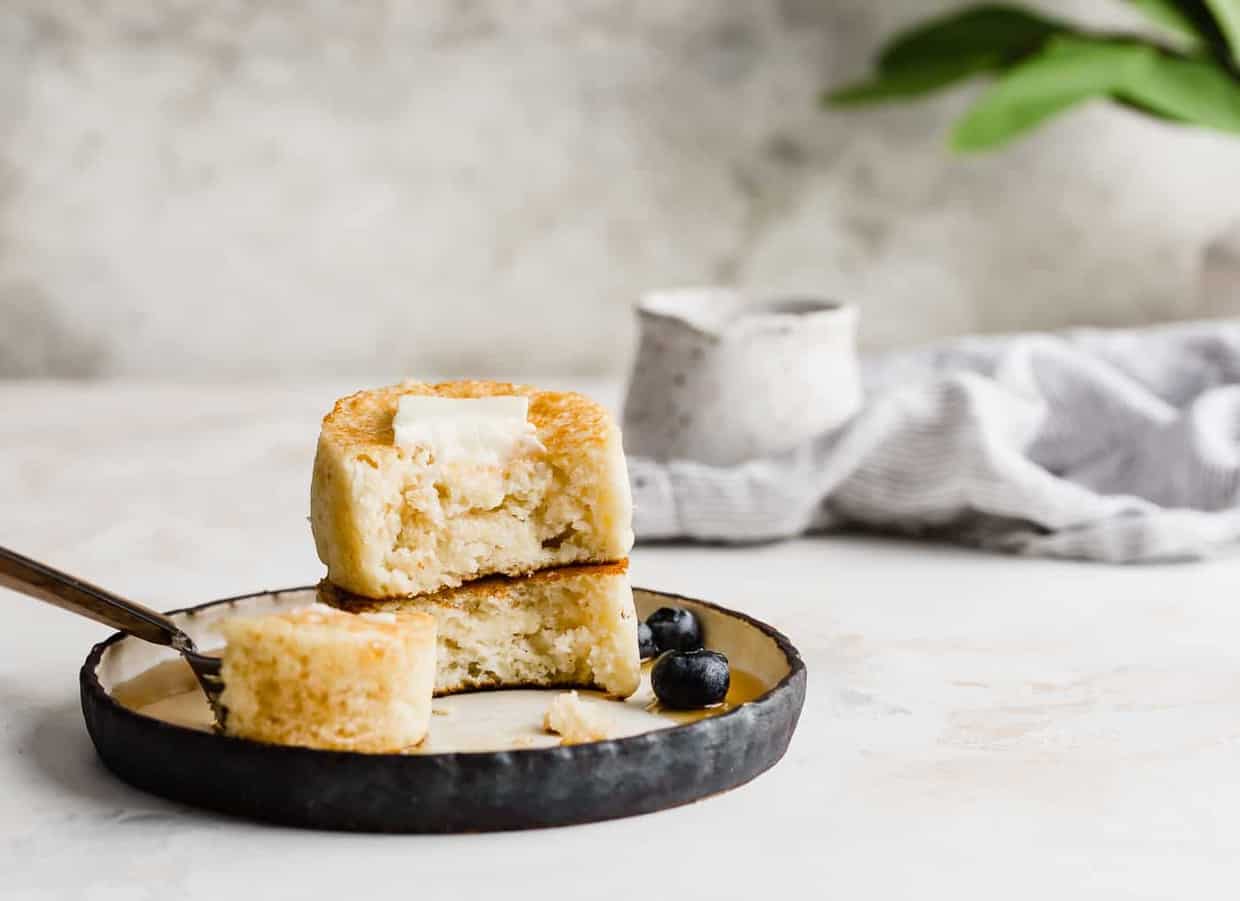
Expert Tips for Perfect Japanese Fluffy Pancakes
Achieving those perfectly tall and wobbly Japanese soufflé pancakes requires a bit of finesse, but with these detailed tips, you’ll master the technique in no time.
Mastering the Japanese Pancake Batter
The true magic behind the classic tall, fluffy Japanese pancakes lies almost entirely in the eggs, specifically the precisely whipped egg whites. This meringue is what gives these pancakes their incredible lift and airy texture. Here’s how to get it right:
- Perfectly Whipped Egg Whites: When beating the egg whites, it’s critical to avoid both over-mixing and under-mixing.
- Under-mixed: If your egg whites are under-mixed, they won’t be able to hold a peak and will collapse, resulting in flat pancakes. They should be firm enough to stand up on their own.
- Over-mixed: Over-mixed egg whites become dry and crumbly, losing their ability to incorporate smoothly into the batter and eventually breaking down. You’ll know they’ve been over-mixed if the mixture looks curdled or breaks easily.
- Just Right: For perfectly mixed egg whites, lift your mixer beaters out of the bowl. The egg whites should form stiff peaks that hold their shape straight up, but with a slight, elegant curl at the very tip. This “soft peak” stage is ideal as it provides maximum air while remaining pliable enough to fold into the batter without deflating. Getting this right creates the perfect air pockets necessary for truly fluffy pancakes.
- Gentle Folding: Once your egg whites are perfect, the next step is folding them into the rest of the batter. Use a rubber spatula and fold gently in a bottom-to-top motion. Be careful not to overmix the combined batter, as this will deflate the delicate egg whites and develop gluten in the flour, resulting in tough, dense, and chewy pancakes instead of the desired light and airy ones. Stir only until just combined; a few small white streaks are acceptable.
Preheating Your Pan for Even Cooking
Consistent heat is vital for evenly cooked and beautifully golden Japanese fluffy pancakes:
- Low and Slow Preheat: It’s crucial to preheat your pan or electric griddle on the lowest possible heat setting for a longer duration. This ensures that the entire cooking surface reaches a uniform temperature, eliminating any hot or cool spots that could lead to unevenly cooked or burnt pancakes. Patience here pays off – a longer, lower preheat is always better than a quick, high-heat one.
- Nonstick Surface is Key: Always use a good quality nonstick skillet or griddle, and don’t forget to generously spray both the pan and the inside of your ring molds with nonstick cooking spray before each batch.
Filling the Molds for Maximum Height
The way you fill your molds significantly impacts the final height and shape of your soufflé pancakes:
- Spoon-Filling Technique: When spooning the pancake batter into the molds, add one spoonful on top of the other, rather than spreading it. This technique helps facilitate vertical growth, encouraging the batter to rise upwards and achieve those impressive tall pancakes.
- Avoid Overfilling: This is a critical rule! The batter should only fill the mold approximately halfway up. Overfilling the molds will prevent the pancakes from rising properly and can cause them to spill over, making them difficult to flip and resulting in a less refined shape.
Cooking Japanese Fluffy Pancakes to Perfection
Unlike regular pancakes, Japanese soufflé pancakes require a specific cooking approach due to their delicate nature and thick consistency:
- Slow and Steady Wins the Race: Japanese pancakes take considerably longer to cook than traditional pancakes. The key is to cook them low and slow. This extended, gentle cooking time ensures that the entire inside of the pancake cooks through thoroughly while the outside browns beautifully without burning. If cooked on higher heat for a shorter time, the exterior will look done, but the inside will remain raw and gooey.
- Cover and Steam: Always cook your Japanese soufflé pancakes in a skillet or on an electric griddle with a lid. Covering the pan helps to trap heat and steam, creating a consistent internal temperature for more even cooking and aiding in the impressive rise. You can even add a tiny bit of water to the skillet, away from the pancakes, to generate additional steam for an even lighter, fluffier texture.
- Know When They’re Ready to Flip: Before attempting to flip these delicate creations, ensure they’ve cooked sufficiently on the first side. The batter should have risen significantly, almost to the top of the mold. You’ll observe distinct bubbles forming on the surface of the pancake, and if you gently wiggle the mold, the center of the batter/pancake should have only a very slight, barely noticeable jiggle. These are all signs that the structure is stable enough for flipping.
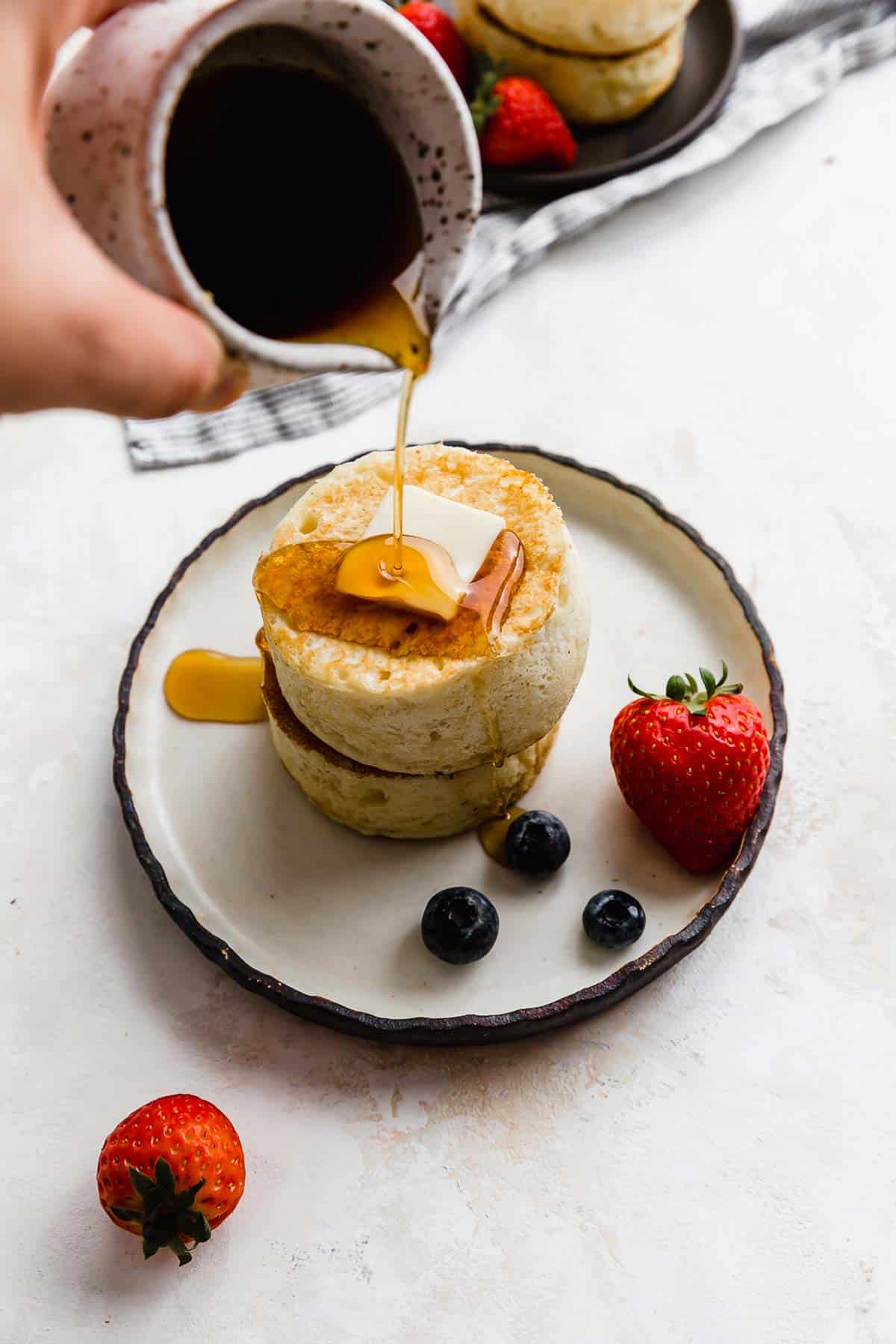
Flipping Japanese Pancakes Safely
Flipping these tall, delicate pancakes can be tricky. Here’s the best approach:
- Using Spatula and Tongs: First, carefully slide a thin spatula under the base of the pancake to release it from the pan. Then, use kitchen tongs to gently grip the sides of the ring molds. With a swift and confident motion, carefully flip the pancake. This two-tool approach provides maximum control.
- One at a Time Method: If you’re only cooking one pancake at a time, you can rest the pancake on your spatula, lift the skillet up towards the pancake, and then carefully turn the pancake onto the skillet. This method minimizes the distance the pancake has to travel.
- The Danger of Premature Flipping: Be absolutely sure the first side is adequately cooked. If you flip too soon, the uncooked batter will ooze out of the mold into the pan, ruining the shape and texture of your soufflé pancake.
Releasing Japanese Pancakes from the Molds
Preserving the perfect shape is key. The easiest way to release your fluffy Japanese pancakes from their molds is by running a butter knife gently around the inside edge of each mold. This action helps to loosen any clinging batter, allowing you to carefully lift and remove the mold without tearing or deflating your beautiful creations.
Enjoying Your Fluffy Japanese Pancakes
You might wonder why there’s a tip on eating pancakes, but it’s important for these special ones!
- Serve Immediately for Best Fluffiness: The signature characteristic of Japanese fluffy pancakes is their incredible height and airy texture. This is achieved by the delicate meringue, which is most stable when warm. They can naturally deflate over time, so for the ultimate experience, eat them within 30 minutes of cooking.
- Troubleshooting Deflation: If your pancakes are deflating too quickly (within a few minutes of cooking), it’s usually a sign that either your egg whites weren’t perfectly whipped (under- or over-mixed) or the pancakes weren’t cooked through sufficiently. Review the “Making Japanese Pancake Batter” and “Cooking Japanese Fluffy Pancakes” tips to ensure your technique is spot on.
Make Ahead, Storing, and Freezing
While these pancakes are best enjoyed fresh, here’s how to manage leftovers:
- Not Recommended for Make-Ahead: Due to the delicate nature of the whipped egg whites, neither the batter nor the fully cooked pancakes are ideal for making ahead of time. The egg whites in the batter can deflate if left to sit too long, and fresh pancakes will lose their optimal fluffiness.
- Storing Leftovers: If you happen to have any leftover soufflé pancakes, store them in a ziplock bag or an airtight container in the refrigerator for 2-3 days. They will lose some of their height and airiness, but the flavor will still be delicious.
- Freezing: For longer storage, you can freeze cooled pancakes in a freezer-safe bag or container for up to 1 month. To reheat, thaw them in the fridge first, then gently warm them in a toaster oven or microwave. Be aware that frozen and thawed soufflé pancakes will inevitably lose a significant amount of their original fluffy height and tender texture. They’re still tasty, but not quite the same as fresh!
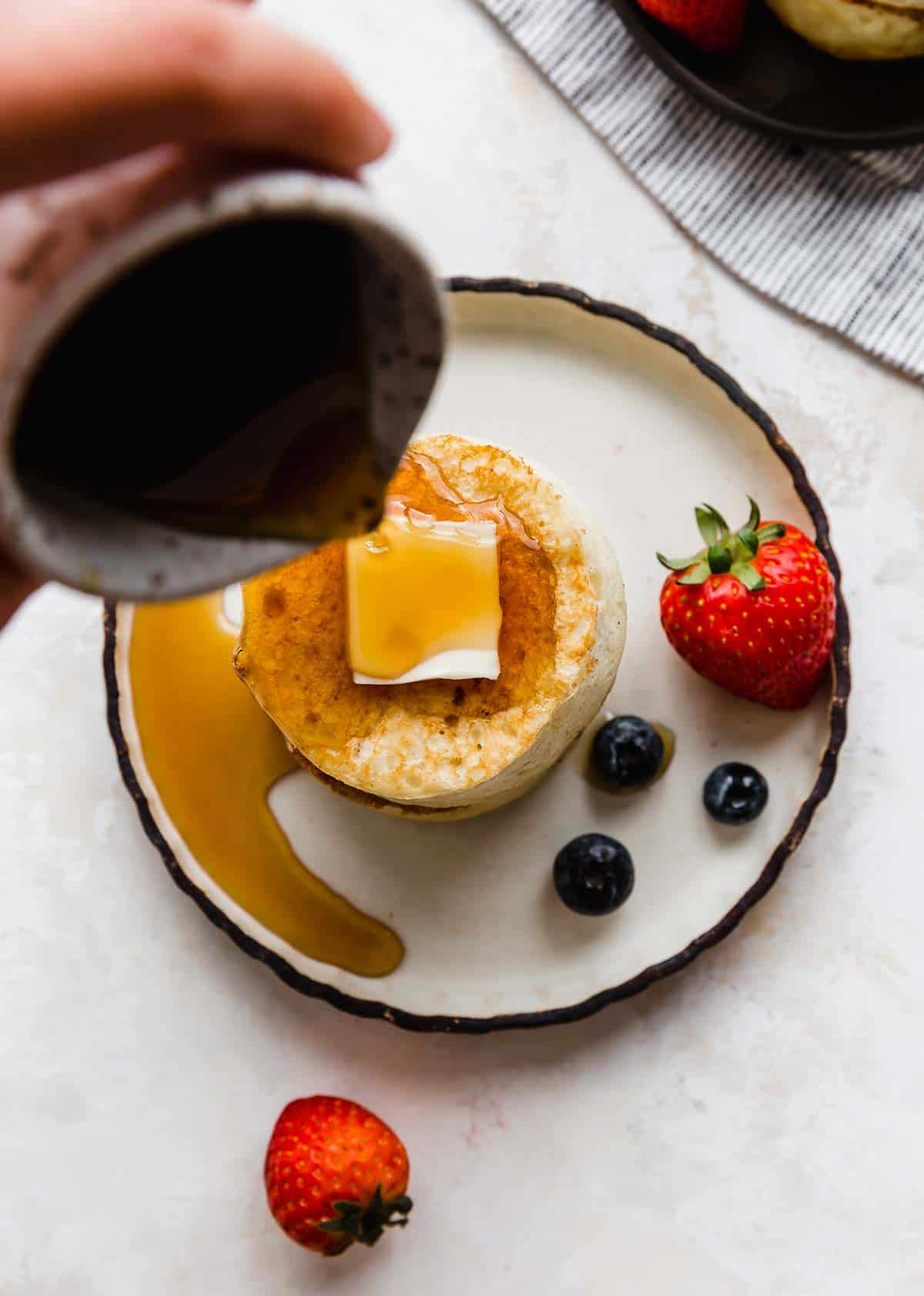
Japanese Fluffy Pancakes: Your Questions Answered
Japanese pancakes, also famously known as soufflé pancakes, are a delicate and decadent breakfast or dessert item characterized by their extraordinary fluffiness, incredible height, and incredibly soft, melt-in-your-mouth texture. Unlike traditional pancakes, they get their signature cloud-like consistency from whipped egg whites (meringue) folded into a rich batter. They can be enjoyed with a wide array of toppings, from fresh fruit and syrup to whipped cream and chocolate chips.
It’s normal for Japanese soufflé pancakes to gradually lose some height after sitting for 30-45 minutes. However, if they deflate rapidly within the first 15-25 minutes, there are typically two main culprits:
- Meringue Issues: The egg whites (meringue) are the primary source of lift and air in the batter. If they were either over-mixed (dry and brittle) or under-mixed (too soft to hold shape), the batter won’t have the structural integrity to maintain its tall form once cooked. Refer to our “Making Japanese Pancake Batter” tips for detailed guidance on whipping perfect egg whites.
- Incorrect Cooking Temperature/Time: Japanese pancakes require a “low and slow” cooking method. If your pan heat was too high, the pancakes might appear golden on the outside but remain undercooked on the inside. An undercooked interior means the internal structure isn’t strong enough to support the height, causing them to collapse. Ensure your pan is evenly preheated on medium-low heat and cooked for the recommended duration under a lid.
To maximize and maintain the fluffiness of your Japanese pancakes, focus on these critical steps: ensure your egg whites are whipped to perfect stiff peaks (not over or under-mixed), guarantee your pan is completely and evenly preheated on low heat to avoid hot spots, and most importantly, cook the pancakes “low and slow” with a lid to ensure they are fully cooked through. While it’s normal for them to slightly deflate after 30-45 minutes, following these steps will ensure they stay beautifully fluffy for an extended period after cooking. Eating them warm and fresh off the pan is always the best way to enjoy their ultimate fluffiness.
Despite their unique texture, Japanese soufflé pancakes share a similar flavor profile to classic buttermilk pancakes, as they utilize many similar base ingredients. They are delightfully buttery, subtly sweet, and wonderfully flavorful. The primary difference is their incredible lightness and airy consistency, making each bite feel like a soft, melt-away cloud.
Yes, you can freeze Japanese pancakes. Store them in a zip-top bag or an airtight container in the freezer for up to one month. However, it’s important to manage expectations: these pancakes are truly best when enjoyed fresh off the pan. Freezing and thawing will cause them to lose a significant amount of their signature fluffy height and delicate texture. While still edible, they won’t have the same cloud-like quality as when freshly made.
Yes, you can reheat Japanese pancakes, but as with freezing, they are undeniably superior when eaten hot and fresh from the skillet. If you have any leftover pancakes, store them in an airtight container in the fridge. To reheat, you can use a microwave for a short burst or a toaster oven for a slightly crisper exterior. However, be aware that reheating will cause the pancakes to deflate a bit and alter their original airy texture.
The possibilities are endless! Classic pairings include fresh berries (strawberries, blueberries, raspberries), sliced bananas, warm maple syrup, a generous dollop of homemade whipped cream, and a dusting of powdered sugar. For more adventurous palates, consider chocolate chips, nuts (pecans, walnuts), coconut shavings, fruit compotes, or even a drizzle of caramel or chocolate sauce.
Flipping Japanese pancakes requires a gentle yet confident hand to maintain their delicate structure. First, carefully use a thin spatula to release the bottom of the pancake from the pan. Then, using kitchen tongs, gently grasp the sides of the ring molds and carefully flip. If you’re cooking one pancake at a time, a useful technique is to rest the pancake on the spatula and then bring the skillet up to the pancake, carefully turning the pancake onto the skillet. For a visual demonstration, refer to the short video provided within this soufflé pancake recipe post above.
While it is challenging to achieve the signature tall, perfectly cylindrical shape without molds, you can attempt to make forms out of aluminum foil. Roll a sturdy sheet of aluminum foil into a strip with dimensions of approximately 3 inches in diameter and 2.5 inches in height. Form this strip into a circle and secure it with a staple or by firmly crimping the ends together. While these homemade molds won’t be as rigid or perfectly shaped as metal ones, the aluminum foil will provide some structure to help the batter cook vertically. Without any form of mold whatsoever, the Japanese pancake batter, being very light and airy, will spread significantly and will have a very difficult time cooking in the desired tall, fluffy shape.
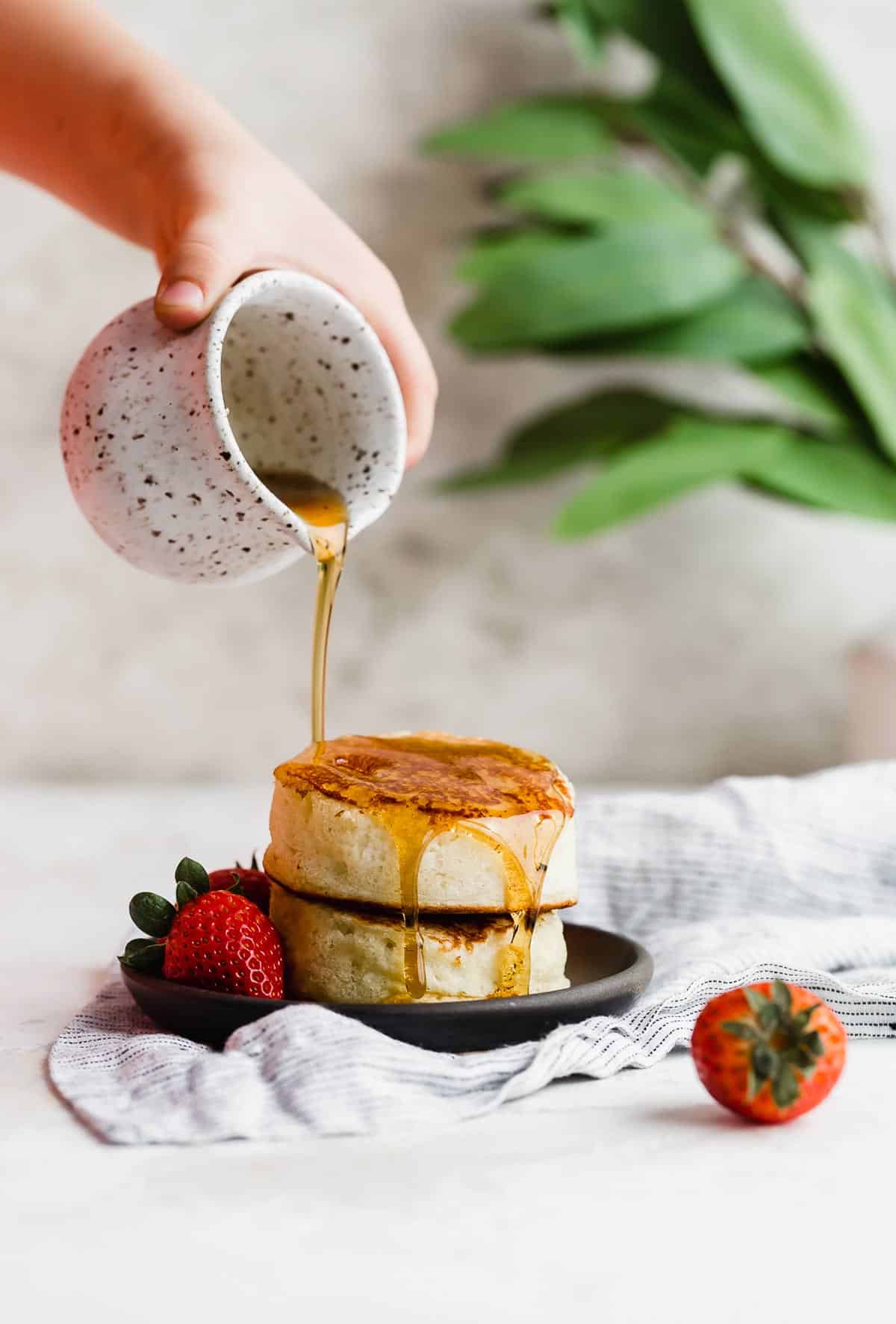
Discover More Delicious Waffle and Pancake Recipes
If you loved these fluffy Japanese pancakes, you’re in for a treat! Explore more delightful breakfast and brunch recipes that will become instant family favorites. From classic staples to unique global variations, our collection has something for every pancake and waffle enthusiast.
- German Pancakes (Dutch Baby): A large, oven-baked pancake that puffs up dramatically and is perfect for a crowd.
- English Pancakes (Crepes): Thin, delicate crepes perfect for sweet or savory fillings.
- Homemade Buttermilk Pancakes: The classic, American-style fluffy pancakes everyone loves.
- Belgian Liege Waffles: Rich, dense, and studded with pearl sugar that caramelizes beautifully.
- Crispy Buttermilk Waffles: Golden and crispy on the outside, tender on the inside – a perfect complement to any syrup.
Did you make this recipe? We’d love to hear about your experience! Leave a star rating and review or scroll below the recipe card to share your thoughts. Your feedback helps other home cooks!
Stay up-to-date with all our latest recipes and culinary adventures by following us on Instagram, TikTok, YouTube, Facebook, and Pinterest. Don’t forget to tag us in your creations!
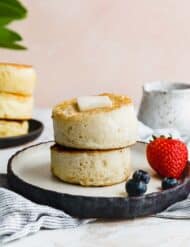
Print
SaveSaved!
Review
Japanese Fluffy Pancakes
Ingredients
- 1 1/2 cups all purpose flour
- 3 tablespoons granulated sugar
- 2 teaspoons baking powder
- 1/4 teaspoon baking soda
- 3/4 teaspoon kosher salt
- 1 1/4 cups buttermilk – at room temperature
- 4 tablespoon butter – melted
- 1 teaspoon vanilla extract
- 2 egg yolks
- 4 egg whites
- 1/4 teaspoon cream of tartar
- cooking spray
Equipment
-
hand mixer
-
OXO mixing bowl set
-
metal ring molds
Instructions
-
You will need 3” x 2.5” wide ring molds for this recipe; I’ve linked to ones I use above in the equipment section. Ensure they are clean and ready for use.
-
In a large bowl, whisk together the all-purpose flour, granulated sugar, baking powder, baking soda, and kosher salt. Mix thoroughly until all dry ingredients are well combined.
-
In a medium bowl, whisk the buttermilk (at room temperature), melted butter, vanilla extract, and egg yolks until the mixture is smooth and fully combined.
-
In a separate medium bowl, using a hand mixer, beat the egg whites and cream of tartar on medium-high speed. Continue beating for about 2-3 minutes, or until stiff, glossy peaks form. (See “Recipe Tips” for details on perfect meringue consistency).
-
Using a rubber spatula, gently stir the buttermilk mixture into the flour mixture until it’s only partially combined – do not overmix. Then, carefully fold the whipped egg whites into the batter until just combined, being very careful not to deflate the egg whites. Overmixing at this stage will result in tough, chewy pancakes.
-
Heat a large nonstick skillet or griddle over medium-low heat. Spray the pan generously with nonstick cooking spray. Also, spray the inside of your 3-inch ring molds generously with nonstick cooking spray.
-
Spoon in the batter: Place the prepared ring molds on the warm pan. Carefully fill each mold with a scant ½ cup of batter. DO NOT OVERFILL; the batter should fill the mold only halfway up. Cover the skillet with a lid (if available) and cook for approximately 5-8 minutes, or until the batter rises to the top of the mold and the bottom of the pancake is golden brown. Bubbles should have formed on the tops of the pancakes, and the center will have a slight, barely perceptible jiggle. (Note: Flipping too soon will cause uncooked batter to ooze out).
-
Using a thin spatula, carefully release the bottom of the pancakes from the pan. Then, grasp the sides of the ring molds with kitchen tongs and carefully flip the pancakes. (If cooking one at a time, you can rest the pancake on the spatula and bring the skillet up to the pancake, then turn the pancake onto the skillet. Refer to our video for this technique!) Cover the pan again and cook the other side for an additional 3-5 minutes, until golden brown and cooked through.
-
Release the pancakes: Transfer the cooked pancakes to a plate. To remove the molds, run a butter knife gently around the inside edge of each mold to help release the pancake, then carefully lift the mold away. Before cooking the next batch, wipe down each mold and re-coat it with cooking spray. Repeat the process with the remaining batter.
-
Serve your Japanese fluffy pancakes warm immediately after cooking with a sprinkling of powdered sugar and fresh fruit, or a drizzle of butter and maple syrup. Remember, these delicate pancakes can deflate over time, so enjoy them within 30 minutes for optimal fluffiness!
Video
Notes
Always cook your Japanese fluffy pancakes low and slow for the best, most even results.
To enhance fluffiness and even cooking: You can also cover the pan with a clean kitchen towel in addition to or instead of a lid. This technique helps to essentially steam the pancakes, contributing to an even lighter and fluffier texture. However, a tight-fitting lid is generally sufficient and more commonly used.
If you use cooking spray that contains flour, your pancakes will release incredibly easily from the molds. However, this can sometimes make flipping them more challenging (precisely because they release so easily and can slide around). If opting for flour-containing spray, consider cooking one pancake at a time to manage the flip more effectively, although this will extend your cooking time.
Nutrition
